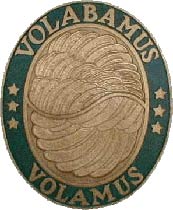|
Roy C. Kirtland is one of several military officers who signed our Register who has a contemporary U.S. military air base named after him: Kirtland Air Force Base in Albuquerque, NM. Among some of the others are Horace Hickam (who was passenger with Kirtland on his flight to Tucson), Hoyt Vandenberg, Clarence Tinker, Hugh Elmendorf, and Frederick Eglin.
Col. Roy C. Kirtland, Date Unknown
(Source: NASM)
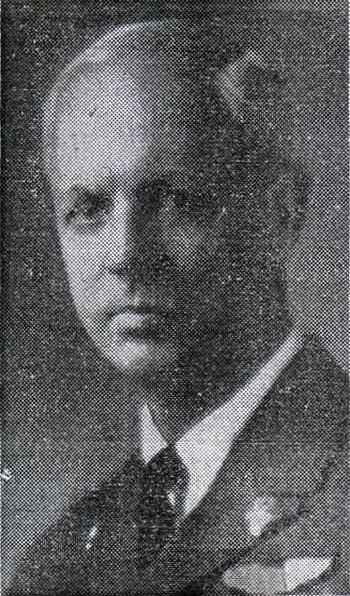 |
Kirtland was born at Fort Benton, MT on May 14, 1874. He died May 2, 1941 at NAS Moffett Field, Sunnyvale, CA. He was 67 years old. The halftone news photograph, right, is from his 1941 obituary, which appeared in the New York Herald Tribune, May 3, 1941.
He began his military career early in the U.S. Army on November 8, 1898. He moved through the lower ranks through Battalion Sergeant Major until promoted on August 23, 1901 to accept a commission as a 2nd Lieutenant of Infantry.
As an officer, he was detailed to aeronautical duty with the Signal Corps Aviation Section in March, 1911. He was an early Army aviator, being one of the first half-dozen men taken into the Section when it was formed in 1911 (see below). He attended the Signal Corps Aviation School at College Park, MD. He was at College Park during the warmer months of 1911 and 1912, then moved to outside of Augusta, GA during the winters of 1911-1912 and 1912-1913. In early 1913, the School moved under orders to support the Maneuver Division at Texas City, TX, where they became the pseudo-operational 1st Aero Squadron (Provisional), with the Squadron becoming official in 1914.
Indeed, while at College Park he was charged with some of the very earliest experimental activities with aircraft. He served on the aviation school faculty as flying instructor 1912-1914 and was involved with the development of photography and free-hand sketching from airplanes (see below).
According to a personal data sheet in his NASM file, he received F.A.I license number 45 on August 31, 1911 and earned his Military Aviator and Expert Aviator ratings in January, 1913. He was thus a member of the Early Birds of aviation, having learned to fly solo an aircraft well-before December 17, 1916. There are conflicting dates for these ratings in some of the news articles in his file (see below).
He served in the Spanish-American War, Philippine Insurrection, Mexican Border War and WWI based in France and England (serving as a Major in charge of motor mechanics). He returned to the U.S. from Europe in January, 1919. He was commissioned to Lt. Col. in November, 1920.
Below, Kirtland in the Army's Wright B Flyer via Mr. Watson and Kirtland AFB (cited, right sidebar). The engine cooling radiator and plumbing occupies the entire left side of the photograph. Note the second seat to his left, and the exposed valve lifters just off his right shoulder. Looking at this engine during flight must have been like observing open heart surgery.
Roy C. Kirtland in Wright B Army Flyer, Ca. 1911 (Source: Watson)
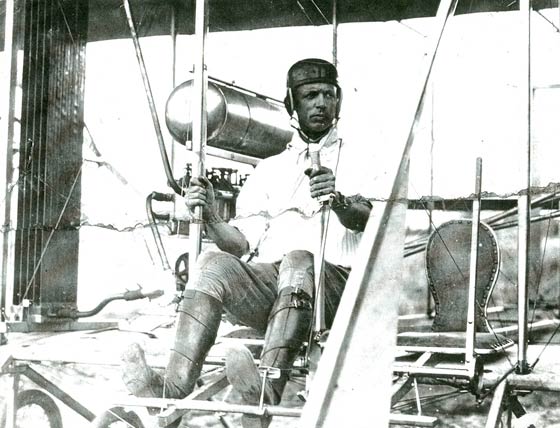 |
In his NASM biographical file, cited left sidebar, is a group of dated but unsourced news articles documenting his early flight experiences. From August 1, 1911 comes the headline "Kirtland Draws Map In Flight". The article begins, "Lieut. Roy C. Kirtland, who three days ago obtained his pilot's license,..." This would suggest he acquired his license in July, not on August 31, as stated above.
Night Landing, NY Times, August 22, 1911 (Source: Watson)
 |
Regardless, the substance of the article was that he took aloft the Army's "Wright Aeroplane" at College Park and flew it for 40 minutes and 10 seconds. While aloft, he traversed 20 miles and, "... drew a complete map of the land." You would think he had invented pie. His superiors, including Captain Chandler (see below) the head of the Army aviators, "... will submit the drawing to Maj. Squier as evidence of the ability and usefulness of the airship." Unfortunately, with aviation still in its early experimental stages, there was little formal training or follow up on their successes or "firsts". They had little guidance or support from the Army's Senior Leadership or even the Signal Corps (who were focused on reconnaissance as the only function for aircraft).
On August 22, 1911, article left, Kirtland, along with Register pilot T.D. Milling, made what was allegedly the first night landing in response to a slight confusion of where they were supposed to be and when. Kirtland had just been recently certificated to fly below).
Below, a photograph from College Park, MD in 1911 that shows "Beck, Arnold, Chandler, Milling, Kirtland" in front of the Wright machine. These men are the first pilots at the Army Signal Corps Aviation School, College Park, MD. Hap Arnold and Thomas Milling signed our Register. Capt. Charles Chandler, at center, was the commander of the school.
Paul Beck, H.H. "Hap" Arnold, Chandler, Thomas Milling and Roy C. Kirtland, College Park, MD, July, 1911 (Source: Watson)
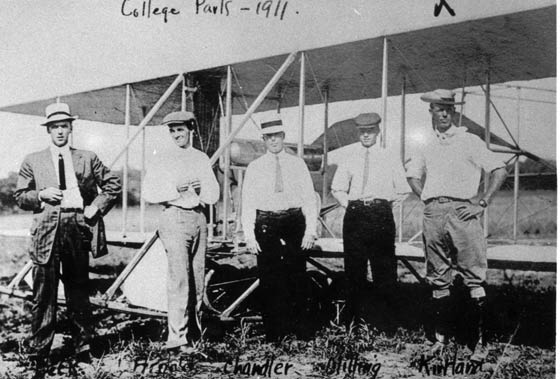 |
First Motion Picture Work, September 2, 1911 (Source: Watson)
 |
From August 11, 1911, in an article describing an airshow at College Park, Kirtland is stated to have received his license "yesterday", implying the date as August 10. The article goes on to say, "Two pylons or stakes were set 1,625 feet apart and around these the officer was required to cut ten figure eights, attain an altitude of 164 feet above ground, and make two landings within a distance of 164 feet from a given mark. Both of Kirtland's landings were almost perfect, on the first the distance being 41 feet away and the next 29 feet."
From August 29, 1911 comes plans for a cross-country flight from College Park to Annapolis, with, perhaps, a short air show at Annapolis. The flight was planned for the afternoon of August 30, with Kirtland accompanied by fellow aviator and Register pilot Hap Arnold. A significant part of this article comes at the end where, "A party of wireless experts ... visited the aviation field and copied specifications of the Army machine preparatory to having wireless apparatus attached to the aeroplanes. While the outfits are for experimental purposes only, they will be tried thoroughly." Thus, Kirtland and Arnold join fellow Register signers Clarence Culver, Albert Hegenberger and William Ocker and early adopters and experimenters with aviation radios.
Kirtland also participated in early use of motion picture cameras on aircraft. At left, and article from the Washington Post of September 2, 1911 that describes Kirtland serving as a photographer during a 20=minute flight with his colleague Hap Arnold.
An article dated September 19, 1911 headlines Kirtland "Soars 3,100 Feet Over Hyattsville", which broke his own previous record. Another map sketch was drawn on September 21st. And if radio wasn't enough, on October 13, 1911 the headline reads "Plan Aero Telegraph". This article describes a semaphoric device consisting of a, "... metal cauldron shaped in the fashion of a silver teapot." A mixture of , "... potassium bromide and muriatic acid ..." would be used to generate smoke, which would be controlled by a valve by the operator/aviator to generate dots and dashes of smoke behind the aircraft. Thus, an airborne Morse code could be used to signal the ground. Nothing was said about any safety issues of carrying acid aloft.
An article dated March 1, 1912 describes Kirtland's experiences with still photography from an airplane at Augusta, GA where the Army aviators were spending the winter. The photos were taken from altitudes above 2,500 feet with the intention of seeing how fast they could be developed and handed over to commanders for tactical purposes. There are other examples of aerial photography by Register pilots and airplanes. They benefitted from these early experiments by Kirtland. They are Victor Dallin, James Piersol, Lockheed Vega NC858E, Monosport NC113K, and others.
Below is a photograph of Captain Charles Chandler, commander of the school, with Kirtland in helmet. The photo was taken the day after the first aircraft machine gun trials (June 7, 1912), when the pilot of the effort, Thomas Milling, was away and Kirtland had to fill in. Note the machine gun held at the ready by Chandler.
Charles Chandler (nearest) and Roy Kirtland, Machine Gun Trials, June 8, 1912 (Source: Watson)
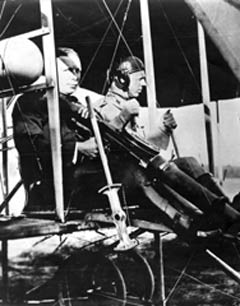 |
Below, early College Park aviators. Other than Arnold, Kirtland and Thomas Milling (kneeling, right), it is unknown if the others signed our Register. They are not among the list of pilot names. For clarity, they are, left to right standing: Capt. Frederick B. Hennessy, Arnold, Kirtland, 2d Lt. Frank M. Kennedy, 1st Lt. Samuel H. McLeary, and 1st Lt. Harold Geiger.
Note at lower left, "[Lewis] Rockwell Killed Sept. 1913". Rockwell Field near San Diego, CA was named after him.
Roy C. Kirtland (center, rear) With Other Early College Park Aviators, Ca. 1911-12 (Source: Watson)
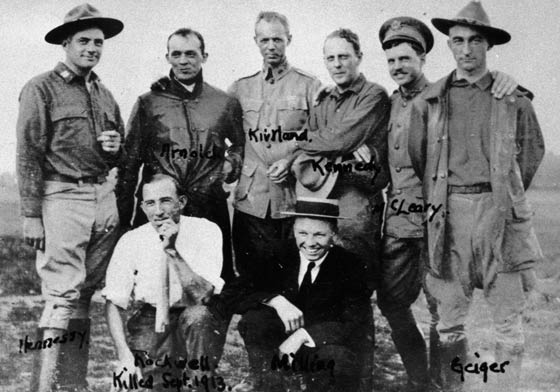 |
A follow-up article on October 14 headlines, "Signal From An Aero", in which the plan of the smoke generating cauldron was executed aloft. It, "... proved the practicality of sending aerial messages from a moving aeroplane." The signals were intelligible to observers a mile away.
Below, Kirtland standing in front of S.C. No. 24, a modified Burgess-Wright, probably late 1914 or early 1915 at North Island, CA, at the Army Signal Corps Aviation School.
Roy C. Kirtland, Ca. 1914-15, San Diego, CA (Source: Watson)
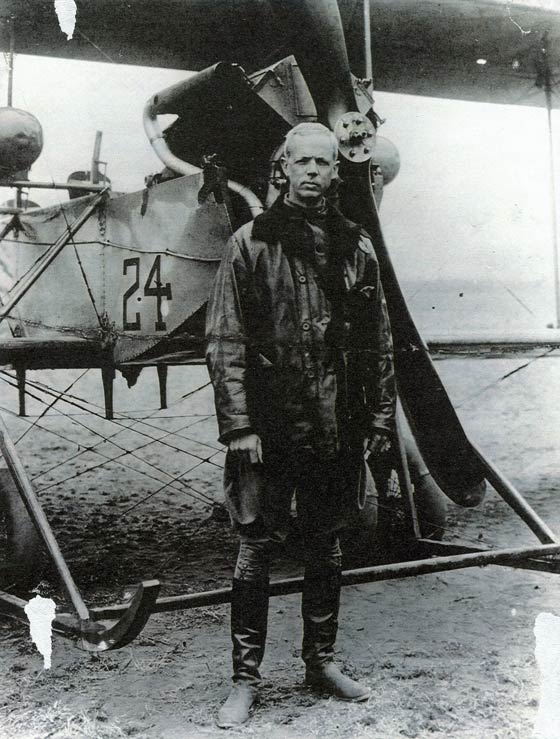 |
Contributor Watson states, "His 'claim to fame' was his role in moving the Army to separate out aviation from the Signal Corps. He was a key player in the 1913 pilot's revolt at Texas City, Texas, to obtain leadership more interested in advancing aviation, and then the 1915 Goodier Court Martial trial, which was a vehicle to attain a complete break with the Signal Corps. Although these attempts were unsuccessful, they got Congress' and Army senior leadership attention and started the process down a path that was overcome by events. The final break wouldn't occur until May 1918 during WWI." For broader coverage of early Army flying activity please see Juliette Hennessy's "The United States Army Air Arm, 1861-1917." Please refer to pages 47-58 for specific exposition of the activities at College Park and Augusta.
From 1926-30 Kirtland was on the Army's General Staff in the newly formed Air Corps (the Army Air Corps Act, creating the Air Corps out of the Air Service, passed in 1926). One of his General Staff duties was appearing at the inauguration of the air mail service. The cachet, below, shared with us by site visitor Jeff Staines documents his presence at the reopening on September 7, 1928. Kirtland was an Early Bird.
U.S. Postal Cachet, Youngstown, OH, September 7, 1928 (Source: Staines)
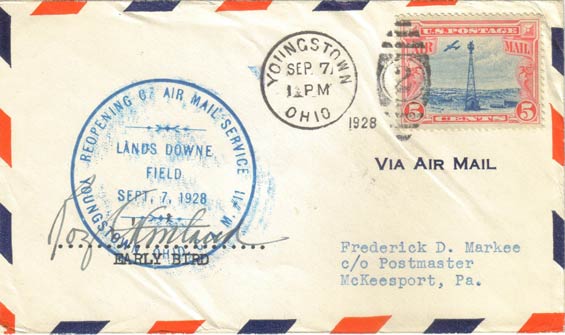 |
Mr. Staines says about this cachet, it, "... is a cover signed by Roy C. Kirtland, who was at the re-opening of Air Mail service (C.A.M.-11) at Lansdowne Field in Ohio back in 1928. This airfield was named after LTCDR Zachary Lansdowne, who died in command of the airship USS Shenandoah, which crashed in Ohio in 1925. Lansdowne was an associate of Roy C. Kirtland."
Col. Roy C. Kirtland, Formal Portrait, Date Unknown (Source: Watson)
 |
Soon after, he visited Tucson. Kirtland signed the Davis-Monthan Airfield Register sometime between April 6 & 9, 1930. He entered neither date nor destination or type of aircraft in the Register. He did allow that he was based at Washington, DC, and that he carried a single passenger, Major H.M. (Horace) Hickam. His namesake, Hickam Field, HI, would become famous during the Pearl Harbor attack that led to WWII.
Kirtland became commander of Langley Field 1930 to 1932, having worked his way through full Colonel, which he received February 1, 1932.
Also in the biographical file is a brief summary of his early life and military service published in the Air Corps Newsletter, #15, August 1, 1936. This account is printed verbatim at the link (Early Birds Web site), so I won't repeat it here.
Kirtland retired from the military in 1938 and was recalled from retirement as WWII loomed in 1941. He was assigned to the Inspector General's Department, Moffet Field in California on April 12 that year and died about a month later.
Besides the Early Birds of Aviation, he was a member of the National Aeronautic Association, American Legion, Order of Daedalians, Order of Carabao, the Army & Navy Club and of the Military Order of the Loyal Legion. Interestingly, Kirtland does not show up on the membership list of this last organization.
---o0o---
Dossier 2.2.119
THIS PAGE UPLOADED: 12/22/09 REVISED: 12/29/09, 01/11/10, 02/17/11
|

